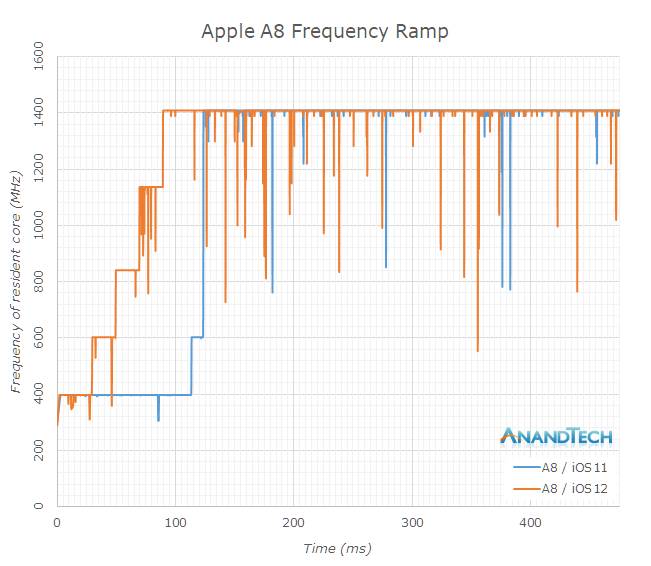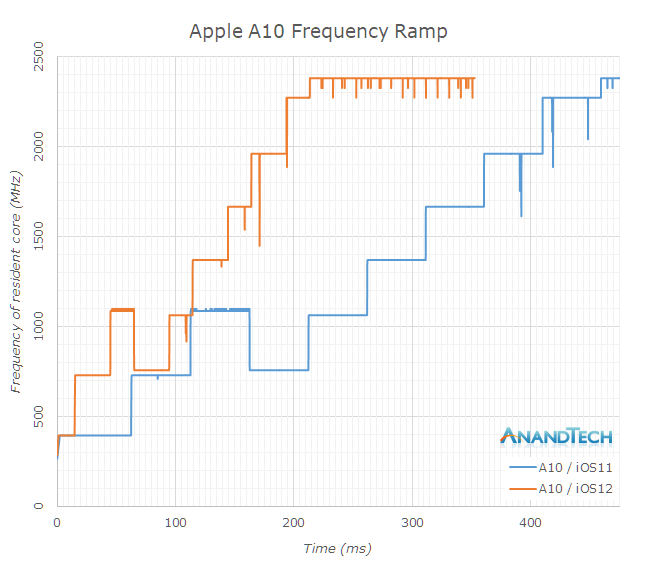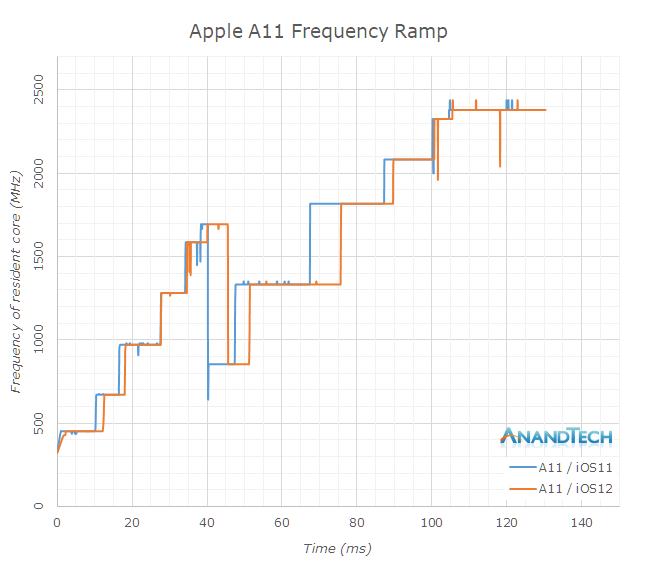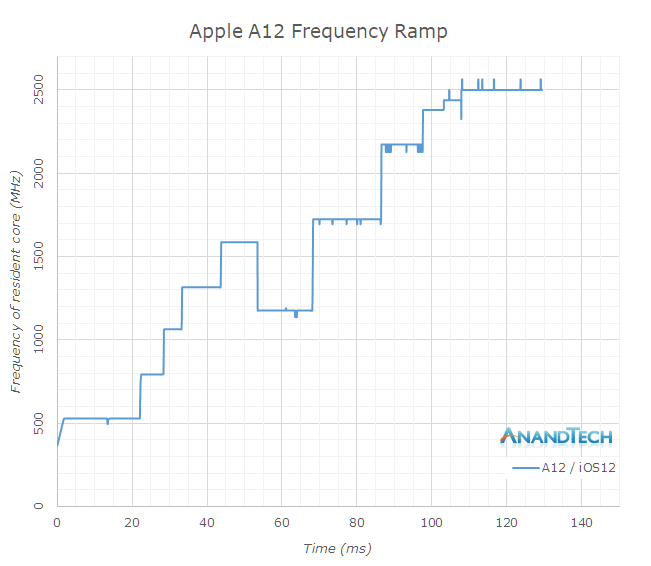The iPhone XS & XS Max Review: Unveiling the Silicon Secrets
by Andrei Frumusanu on October 5, 2018 8:00 AM EST- Posted in
- Mobile
- Apple
- Smartphones
- iPhone XS
- iPhone XS Max
System Performance
While synthetic test performance is one thing, and hopefully we’ve covered that well with SPEC, interactive performance in real use-cases behaves differently, and here software can play a major role in terms of the perceived performance.
I will openly admit that our iOS system performance suite looks extremely meager: we are only really left with our web browser tests, as iOS is quite lacking in meaningful alternatives such as to PCMark on the Android side.

Speedometer 2.0 is the most up-to-date industry standard JavaScript benchmark which tests the most common and modern JS framework performance.
The A12 sports a massive jump of 31% over the A11, again pointing out that Apple’s advertised performance figures are quite underselling the new chipset.
We’re also seeing a small boost from iOS 12 on the previous generation devices. Here the boost comes not only thanks to an a change in how iOS’s scheduler handles load, but also thanks to further improvements in the ever evolving JS engine that Apple uses.

WebXPRT 3 is also a browser test, however its workloads are more wide-spread and varied, containing also a lot of processing tests. Here the iPhone XS showcases a smaller 11% advantage over the iPhone X.
Former devices here also see a healthy boost in performance, with the iPhone X ticking up from 134 to 147 points, or 10%. The iPhone 7’s A10 sees a larger boost of 33%, something we’ll get into more detail in a little bit.
iOS12 Scheduler Load Ramp Analyzed
Apple promised a significant performance improvement in iOS12, thanks to the way their new scheduler is accounting for the loads from individual tasks. The operating system’s kernel scheduler tracks execution time of threads, and aggregates this into an utilisation metric which is then used by for example the DVFS mechanism. The algorithm which decides on how this load is accounted over time is generally simple a software decision – and it can be tweaked and engineered to whatever a vendor sees fit.
Because iOS’s kernel is closed source, we’re can’t really see what the changes are, however we can measure their effects. A relatively simple way to do this is to track frequency over time in a workload from idle, to full performance. I did this on a set of iPhones ranging from the 6 to the X (and XS), before and after the iOS12 system update.
Starting off with the iPhone 6 with the A8 chipset, I had some odd results on iOS11 as the scaling behaviour from idle to full performance was quite unusual. I repeated this a few times yet it still came up with the same results. The A8’s CPU’s idled at 400MHz, and remained here for 110ms until it jumped to 600MHz and then again 10ms later went on to the full 1400MHz of the cores.
iOS12 showcased a more step-wise behaviour, scaling up earlier and also reaching full performance after 90ms.
The iPhone 6S had a significantly different scaling behaviour on iOS11, and the A9 chip’s DVFS was insanely slow. Here it took a total of 435ms for the CPU to reach its maximum frequency. With the iOS12 update, this time has been massively slashed down to 80ms, giving a great boost to performance in shorter interactive workloads.
I was quite astonished to see just how slow the scheduler was before – this is currently the very same issue that is handicapping Samsung’s Exynos chipsets and maybe other Android SoCs who don’t optimise their schedulers. While the hardware performance might be there, it just doesn’t manifest itself in short interactive workloads because the scheduler load tracking algorithm is just too slow.
The A10 had similar bad characteristics as the A9, with time to full performance well exceeding 400ms. In iOS12, the iPhone 7 slashes this roughly in half, to around 210ms. It’s odd to see the A10 being more conservative in this regard compared to the A9 – but this might have something to do with the little cores.
In this graph, it’s also notable to see the frequency of the small cores Zephyr cores – they start at 400MHz and peak at 1100MHz. The frequency in the graph goes down back to 758MHz because at this point there was a core switch over to the big cores, which continue their frequency ramp up until maximum performance.
On the Apple A11 – I didn’t see any major changes, and indeed any differences could just be random noise between measuring on the different firmwares. Both in iOS11 and iOS12, the A11 scales to full frequency in about 105ms. Please note the x-axis in this graph is a lot shorter than previous graphs.
Finally on the iPhone XS’s A12 chipset, we can’t measure any pre- and post- update as the phone comes with iOS12 out of the box. Here again we see that it reaches full performance after 108ms, and we see the transition of the tread from the Tempest cores over to the Vortex cores.
Overall, I hope this is the best and clear visual representation of the performance differences that iOS12 brings to older devices.
In terms of the iPhone XS – I haven’t had any issues at all with performance of the phone and it was fast. I have to admit I’m still a daily Android user, and I use my phones with animations completely turned off as I find they get in the way of the speed of a device. There’s no way to completely turn animation off in iOS, and while this is just my subjective personal opinion, I found they are quite hampering the true performance of the phone. In workloads that are not interactive, the iPhone XS just blazed through them without any issue or concern.















253 Comments
View All Comments
name99 - Saturday, October 6, 2018 - link
If you're going to count like that, you need to throw in at least 7 Chinook cores (small 64-bit Apple-designed cores that act as controllers for various large blocks like the GPU or NPU).[A Chinook is a type of non-Vortex wind, just like a Zephyr, Tempest, or Mistral...]
There's nothing that screams their existence on the die shots, but what little we know about them has been established by looking at the OS binaries for the new iPhones. Presumably if they really are minimal and require little to no L2 and smaller L1s (ie regular memory structures that are more easily visible), they could look like pretty much any of that vast sea of unexplained territory on the die.
It's unclear what these do today apart from the obvious tasks like initialization and power tracking. (On the GPU it handles thread scheduling.)
Even more interesting is what Apple's long term game here is? To move as much of the OS as possible off the main cores onto these auxiliary cores (and so the wheel of reincarnation spins back to System/360 Channel Controllers?) For example (in principle...) you could run the file system stack on the flash controller, or the network on a controller living near the radio basebands, and have the OS communicate with them at a much more abstract level.
Does this make sense for power, performance, or security reasons? Not a clue! But in a world where transistors are cheap, I'm glad to see Apple slowly rethinking OS and system design decisions that were basically made in the early 1970s, and that we've stuck with ever since then regardless of tech changes.
ex2bot - Sunday, October 7, 2018 - link
Much appreciate the review!s.yu - Monday, October 8, 2018 - link
Great job as always Andrei!I would only have hoped for a more thorough exploration of the limits of the portrait mode, to see if Apple really makes proper use of the depth map, taking a photo in portrait mode in a tunnel to see if the amount of blur is applied according to distance for example.
Mic_whos_right - Tuesday, October 9, 2018 - link
Thanks for this comment--Now I know why nothing last year. Great Anandtech standard of a review! Always above my intellect of understanding w/ info overload that teaches me a lot of the product.Moh Qadee - Thursday, November 1, 2018 - link
Thank you for this great detailed review. I have been coming back to this review before making a purchase. Please make an comparison article of Iphone XS gaming vs other smartphones in market. How much does thermal make difference over longer periods before it starts to throttle or heat up. Would be able to give an approx time before you noticed heat while gaming on XS? I don't mind investing in an expensive phone as long as thermals doesn't limit the performance. There are phones like Razor 2 or Rog out. People make an comparison with an iPhone as it doesn't require much cooling. I wonder if gaming for above 20+ mins makes it challenging for Iphone to heat up enough that you should be worried about?Ahadjisavvas - Monday, November 19, 2018 - link
And the exynos m3 had 12 execution ports right? Can you elaborate on the major differences between the design of the vortex core in the a12 and the meerkat core in the m3? I would deeply appreciate it if you could.Ahadjisavvas - Monday, November 19, 2018 - link
And the exynos m3 has 12 execution ports right? Can you elaborate on the main differences between the design of the exynos m3 and the vortex core,that'll be really helpful and informative as well. Also,are you planning on writing a piece about the a12x soc, it'll be really interesting to hear how far apple has come with the soc on the 2018 ipad pro.alysdexia - Monday, May 13, 2019 - link
"Now what is very interesting here is that this essentially looks identical to Apple’s Swift microarchitecture from Apple's A6 SoC."This comparison doesn't make sense and it seems like you took the same execution ports to determine whether the chips are identical, when the ports could be arbitrary for each release. Rather I took the specifications (feature size, revision) and dates of each from these pages: https://en.wikipedia.org/wiki/Comparison_of_ARMv7-... and https://en.wikipedia.org/wiki/Comparison_of_ARMv8-... to come up with these matches: Cortex-A15-A9 A6, Cortex-A15-A9 A6X, Cortex-A57-A53 A7, Cortex-A57-A53 A8, Cortex-A57-A53 A8X, Cortex-A57-A53 A9, Cortex-A57-A53 A9X, Cortex-A73 A10, Cortex-A73 A10X, Cortex-A75 A11, Cortex-A76 A12, Cortex-A76 A12X. For exemplum 5 execution ports could be gotten (I'm no computer engineer so this is a SWAG.) from the 3 in Cortex-A9 subtracted from the 8 in Cortex-A15 but the later big.LITTLEs with 9 and 5 ports could be split from 7 or 8 as (7+2)+(7−2) or (8+1)+(8−3). You need to correct the Anandtech and Wikipedia pages.
faster -> swifter, swiftlier
ISO -> iso -> idem
's !-> they; 1 != 2
great:small::big:lite::mickel:littel
RSAUser - Friday, October 5, 2018 - link
I still don't like iOS tendency towards warmer photos than it is irl.DERSS - Saturday, October 6, 2018 - link
It is weird because it is warmer in bright light and bleaker in dim light.Why can not they just even it out, make the photos less yellowish in bright light and less bleak in dim light?